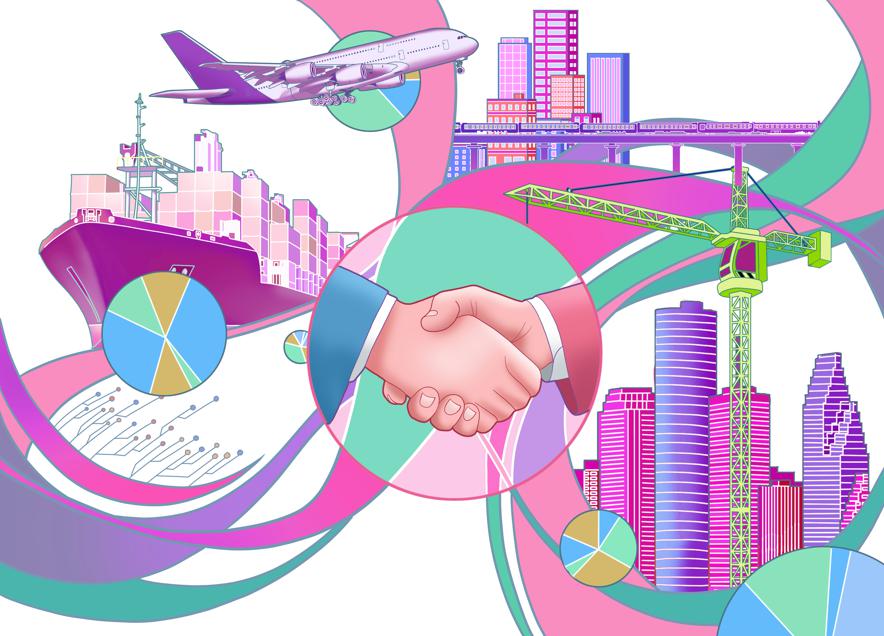West's development plans face uncertainties
West's development plans face uncertainties
By Li Bing | China Daily | Updated: 2023-11-03 06:46

JIN DING/CHINA DAILY
Improving infrastructure connectivity is the most significant contribution of the Belt and Road Initiative to regional and global development in the 10 years since its launch. Belt and Road projects have galvanized about $1 trillion investment in diverse infrastructure sectors. The projects have also created more than 420,000 jobs and helped lift about 40 million people out of poverty, mainly in developing countries.
This prompted developed economies to launch various initiatives involving substantial investment, although the initiatives continue to face formidable challenges in implementation.
A series of infrastructure initiatives, including the United States' "Build Back Better World", the European Union's "Global Gateway", and the G7's "Partnership for Global Infrastructure and Investment" targeting the Global South, have been launched by the developed world in an attempt to counter the Belt and Road Initiative.
The developed world has vowed to invest huge amounts to promote these initiatives. For example, the G7 leaders pledged to mobilize $600 billion by 2027 for the PGII projects, and work out ambitious blueprints to make the initiative a success.
Also, at the G20 Summit in New Delhi in September, a group of G20 member states launched the "India-Middle East-Europe Economic Corridor", with the aim of improving economic connectivity between the Indian sub-continent and Europe via the Middle East.
While the initiatives, including the IMEEC, may sound promising, the reality is different. Western countries have failed to give a clear list of funding sources, with several projects indicating a preference for leveraging private investment despite the disinterest of private investors to put money in such projects in developing and less-developed countries because of the slow and low returns and high risks.
The West has also been facing serious funding shortage even for domestic infrastructure projects. An American Society of Civil Engineers report says there is $2.6 trillion infrastructure investment gap while the Joe Biden administration has pledged only $550 billion for projects under the Infrastructure Investment and Jobs Act plan.
Domestic infrastructure development projects in EU countries, too, are facing funding problems. Additionally, the EU has a €470 billion ($497.12 billion) shortage a year through to 2030 in its climate fund which could undermine its fight against climate change, and €65 billion shortage in its digital economy fund, which could derail its digital economy infrastructure development plan.
Firm promises but slow action has become a typical characteristic of the West. The developed economies promising to provide climate financing for developing countries to help the latter adapt to and mitigate climate change is a typical example of such a promise, said Republic of the Congo President Denis Sassou Nguesso at the "New Global Financing Compact Summit" in France in June. Sassou Nguesso said developed countries pledged to provide $100 billion annually to assist developing countries in addressing climate change, a goal that has remained unfulfilled since its establishment in 2009.
Development is at the heart of China's reform and opening-up. In the 45 years since the launch of reform and opening-up, infrastructure connectivity has played a vital role in fueling China's fast-paced economic growth.
In a report "For the Common Values and Dignity of All Humanity: China's Practice of and Contribution to Global Human Rights Governance", published on Sept 19,2023, China has underscored the role of development, saying it is key to solving almost all problems; it is the foundation for human rights protection and essential to making people happy.
China is ready to share its Belt and Road experience, as well as its overall economic development policy with countries of the Global South so they can take a leaf out of it, if they want to, and apply it to boost their development. Yet China is a big supporter of every country choosing the development model that best suits it.
The Belt and Road Initiative has helped boost development and alleviate poverty in many countries of the Global South. China has helped various developing countries in implementing more than 6,000 livelihood projects, boosting local development, and built agricultural technology demonstration centers in more than 30 countries. It has also nurtured nearly 20 million development talents in more than 160 countries, with special focus on vocational education through initiatives such as the "Lu Ban Workshop", which has trained a large number of skilled workers in over 20 countries.
Western countries are increasingly turning their dislike for the Belt and Road Initiative into efforts to mobilize funds for infrastructure projects in the Global South. As the saying goes, "Imitation is the sincerest form of flattery". Indeed, the Western economies have been trying to counter the Belt and Road Initiative by launching initiatives that seem like the China-proposed infrastructure connectivity plan.
According to the World Bank, the global infrastructure investment demand is projected to reach $94 trillion by 2040, with a funding gap of nearly $18 trillion, which means investment in infrastructure in developing countries could become a new, powerful driver of global development.
And as David Sacks, a fellow at the think tank Council on Foreign Relations, said of the BRI, "it is important to note that it is addressing a real issue, namely the urgent and unmet need for infrastructure investment".
Yet Western economies are becoming more inclined to view things through a "zero-sum game" lens rather than engaging in win-win cooperation. They have been trying to tarnish Chinese investments in Belt and Road countries, especially African countries, by claiming they are environmentally unsustainable and "debt traps" for the host countries.
In reality, however, as the Green Silk Road gains momentum, the sustainability of China's infrastructure projects is becoming even more evident. Besides, the proportion of host countries' Belt and Road-related debt is minimal. According to the "Debt Justice" report in the United Kingdom, the 49 African countries whose data are available owe only 12 percent of their external debt to China compared with 35 percent to Western private institutions. And while Chinese loans come with an average interest rate of 2.7 percent, Western loans charge an interest rate of 5 percent.
Perhaps Western countries should take a moment to reflect. In fact, it would be beneficial to both them and the African countries if they redirect their efforts toward cooperation in infrastructure development and develop a win-win relationship with China and the host countries.
The author is an assistant research fellow at the National Institute of International Strategy at the Chinese Academy of Social Sciences.
The views don't necessarily represent those of China Daily.
If you have a specific expertise, or would like to share your thought about our stories, then send us your writings at opinion@chinadaily.com.cn or comment@chinadaily.com.cn.
























